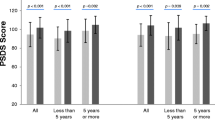Abstract
Rapid growth in the demand for genetic counselors has led to a workforce shortage. There is a prevailing assumption that the number of training slots for genetic counseling students is linked to the availability of clinical supervisors. This study aimed to determine and compare barriers to expansion of supervision networks at genetic counseling training programs as perceived by supervisors, non-supervisors, and Program Directors. Genetic counselors were recruited via National Society of Genetic Counselors e-blast; Program Directors received personal emails. Online surveys were completed by 216 supervisors, 98 non-supervisors, and 23 Program Directors. Respondents rated impact of 35 barriers; comparisons were made using Kruskal-Wallis and Wilcoxon ranked sum tests. Half of supervisors (51%) indicated willingness to increase supervision. All non-supervisors were willing to supervise. However, all agreed that being too busy impacted ability to supervise, highlighted by supervisors’ most impactful barriers: lack of time, other responsibilities, intensive nature of supervision, desire for breaks, and unfilled positions. Non-supervisors noted unique barriers: distance, institutional barriers, and non-clinical roles. Program Directors’ perceptions were congruent with those of genetic counselors with three exceptions they rated as impactful: lack of money, prefer not to supervise, and never been asked. In order to expand supervision networks and provide comprehensive student experiences, the profession must examine service delivery models to increase workplace efficiency, reconsider the supervision paradigm, and redefine what constitutes a countable case or place value on non-direct patient care experiences.

Similar content being viewed by others
References
American Board of Genetic Counseling (ABGC) (2011). “Practice Analysis and Information.” Retrieved May 01, 2017, from http://www.abgc.net/Certification/practice_analysis_and_information.asp.
Accreditation Council for Genetic Counselors (ACGC) (2013). “Standards of Accreditation for Graduate Programs in Genetic Counseling.” Retrieved May 01, 2017, from http://gceducation.org/Pages/Standards.aspx.
Atzinger, C. L., He, H., & Wusik, K. (2015). Measuring the effectiveness of a genetic counseling supervision training conference. Journal of Genetic Counseling, 25(4), 698–707. https://doi.org/10.1007/s10897015-9917-6.
Borders, L. D., Eubanks, S., & Callanan, N. (2006). Supervision of psychosocial skills in genetic counseling. Journal of Genetic Counseling, 15(4), 211–223. https://doi.org/10.1007/s10897-006-9024-9.
Callanan, N., McCarthy Veach, P., & LeRoy, B. S. (2016). The evolution of clinical supervision in genetic counseling: Theory, research, and practice. The Clinical Supervisor, 35, 210–226.
Cory, G., Haynes, R., Moulton, P. & Muratori, M. (2010). Clinical supervision in the helping professions: A practical guide (2nd ed.). (pp.95-118). Alexandria: American counseling association.
Doyle, D., Awwad, R., Austin, J., Baty, B., Bergner, A., Brewster, S., Erby, L., et al. (2016). 2013 review and update of the genetic counseling practice based competencies by a task force of the accreditation Council for Genetic Counseling. Journal of Genetic Counseling, 25(5), 868–879. https://doi.org/10.1007/s10897-016-9984-3.
Eubanks Higgins, S., McCarthy Veach, P., MacFarlane, I. M., Borders, L. D., LeRoy, B., & Callanan, N. (2013). Genetic counseling supervisor competencies: Results of a Delphi study. Journal of Genetic Counseling, 22(1), 39–57. https://doi.org/10.1007/s10897-012-9512-z.
Gu, L., McCarthy Veach, P., Eubanks, S., LeRoy, B. S., & Callanan, N. (2011). Boundary issues and multiple relationships in genetic counseling supervision: Supervisor, non supervisor, and student perspectives. Journal of Genetic Counseling, 20(1), 35–48. https://doi.org/10.1007/s10897-010-9318-9.
Hendrickson, S. M., McCarthy Veach, P., & LeRoy, B. S. (2002). A qualitative investigation of student and supervisor perceptions of live supervision in genetic counseling. Journal of Genetic Counseling, 11(1), 25–49. https://doi.org/10.1023/A:1013868431533.
Holle, J. (2016). Accepting a nonclinical position after graduate school. Perspectives in Genetic Counseling, 38(4), 15.
Larsen Haidle, J. (2015). 2015 NSGC presidential address: Gifts of genetic counselors: life’s leadership lessons. Journal of Genetic Counseling, 24(1), 1–5. https://doi.org/10.1007/s108970149 798-0.
Lindh, H. L., McCarthy Veach, P. M., Cikanek, K., & LeRoy, B. S. (2003). A survey of clinical supervision in genetic counseling. Journal of Genetic Counseling, 12(1), 23–41. https://doi.org/10.1023/A:1021443100901.
McCarthy Veach, P., & LeRoy, B.S. (2009). Student supervision: Strategies for providing direction, guidance, and support. In J. L. S. W. R. Uhlmann, & B.M. Yashar (Ed.), A guide to genetic counseling (2nd ed., pp. 401-434): Hoboken: Wiley.
National Society of Genetic Counselors (NSGC) (2014). “2014 Professional Status Survey: Work Environment.” Retrieved May 01, 2017, from http://www.nsgc.org/p/cm/ld/fid=68.
National Society of Genetic Counselors (NSGC) (2016). “2016 Professional Status Survey: Work Environment.” Retrieved May 01, 2017, from http://www.nsgc.org/p/cm/ld/fid=68.
Pan, V., Yashar, B. M., Pothast, R., & Wicklund, C. (2016). Expanding the genetic counseling workforce: Program directors' views on increasing the size of genetic counseling graduate programs. Genetics in Medicine, 18(8), 842–849. https://doi.org/10.1038/gim.2015.179.
Pirzadeh-Miller, S., Robinson, L. S., Read., P., & Ross, T.S. (2016). Genetic counseling assistants: An integral piece of the evolving genetic counseling service delivery model. Journal of Genetic Counseling, https://doi.org/10.1007/s10897-0160039-6.
Qualtrics software, Version May 2016 of Qualtrics. Copyright ©. (2015). Qualtrics. Qualtrics and all other Qualtrics product or service names are registered trademarks or trademarks of Qualtrics, Provo, UT, USA. http://www.qualtrics.com.
StataCorp. (2013). Stata statistical software: Release 13. College Station: StataCorp LP.
Acknowledgements
This study was completed in partial fulfillment of the requirements for the first author’s Master of Science in genetic counseling from MD Anderson Cancer Center UT Health Graduate School of Biomedical Sciences. Dr. Christina Palmer served as Action Editor on the manuscript review process and publication decision.
Author information
Authors and Affiliations
Corresponding author
Ethics declarations
Conflict of Interest
Jennifer Hoskovec is the Chair of the Genetic Counselor Workforce Working Group. Jordan Berg, Patricia McCarthy Veach, Shahrukh Hashmi, Allison Ownby, and Claire N. Singletary declare that they have no conflict of interest.
Human Studies and Informed Consent
All procedures followed were in accordance with the ethical standards of the responsible committee on human experimentation (institutional and national) and with the Helsinki Declaration of 1975, as revised in 2000 (5). Informed consent was obtained from all participants for being included in the study.
Animal Studies
No animal studies were carried out by the authors for this article.
Electronic supplementary Materials
ESM 1
(DOCX 44 kb)
Rights and permissions
About this article
Cite this article
Berg, J., Hoskovec, J., Hashmi, S.S. et al. Relieving the Bottleneck: An Investigation of Barriers to Expansion of Supervision Networks at Genetic Counseling Training Programs. J Genet Counsel 27, 241–251 (2018). https://doi.org/10.1007/s10897-017-0142-3
Received:
Accepted:
Published:
Issue Date:
DOI: https://doi.org/10.1007/s10897-017-0142-3




